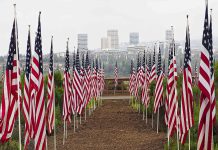When the next earthquake will come, not if, is the question.
But, are you thinking that the epicenter has to be in proximity to where you live?
The Sacramento-San Joaquin Delta is one of California’s most unique and important natural assets. So, the biggest earthquake threat may just lie in the North, and flow out to the Pacific Ocean, under the Golden Gate Bridge. The Delta was built by farmers – not engineered – 100 years ago. A major fault line runs through it, and is 134 years into a 132-year cycle of large earthquake activity. A little shaking of the ground, or even a major storm, could cause the levees to fail, and the seawater intrusion would contaminate a major source of water supply, for a minimum of six months.
Something to think about as you prepare for the next Big One.
Rather than list everything you could do to get ready, if you want to take action and need a great resource for intimate specifics, visit www.ready.gov. Here are some generalities to help start the process.
Before an earthquake, you should create a Family Disaster Plan. Meet and discuss types of disasters so you can prepare for and respond to. Discuss what to do if asked to evacuate, what to do with pets, what two safe meeting places you will use. For instance, OC Fairgrounds is designated as a FEMA location, in case of a San Onofre nuclear event.
Does everyone know how to use a fire extinguisher? Do you have properly installed fire detectors? Do you have tools and know where and how to shut off the utilities?
And, don’t forget to practice your plan.
What should you have in case of emergency? Proper planning is the key. For more particulars, visit the website, but here are a couple of my general suggestions, and shortcuts.
I went to Costco, and bought a small roller bag / duffle bag to contain many of the basics, which should rotated and checked on every six months. In that bag, I have all my paperwork of emergency phone numbers, checklists, personal paperwork, family records, identification, and money.
I have kids, so we enjoy camping. I have one storage bin that has the dual purpose of also acting as an emergency kit. That way I do not have to have extra storage for necessities like tools, supplies, first-aid kits, radio and camping stuff that will come in handy in case you have to camp in an emergency. If no kids, then build the kit, and it is suggested that you have smaller versions for your cars.
Water is an important emergency storage item, as you can survive without food or lattes. You can use store-bought water, or use former alcohol containers, like wine bottles, as they are aseptic containers. One gallon, per person, for three days supply is recommended.
Food is a necessity – lay in at least a three-day supply of non-perishable foods that need no preparation or refrigeration. Ready-to-eat canned meats, fruits and vegetables. High energy foods, pb&j, crackers, granola bars and trail mix.
Think about any medicines.
Comfort foods and entertainment needs only as practical.
After an event, shut off utilities. Do not drink, bathe or wash anything with tap water until advised it is safe. Emergency drinking water sources are hot water heaters that hold 30-60 gallons of water, toilet reservoir tanks, melted ice cubes or the juices in canned foods. You can also disinfect water for drinking with purification tablets, boiling or unscented chlorine bleach.
So, hug your loved ones, today. Start the ball rolling with a brief conversation, today. Start by getting an emergency kit, adding to it.
It is a matter of when, not if you will need it.
What green plans do you have for Earth Day? JimFitzEco@gmail.com.




